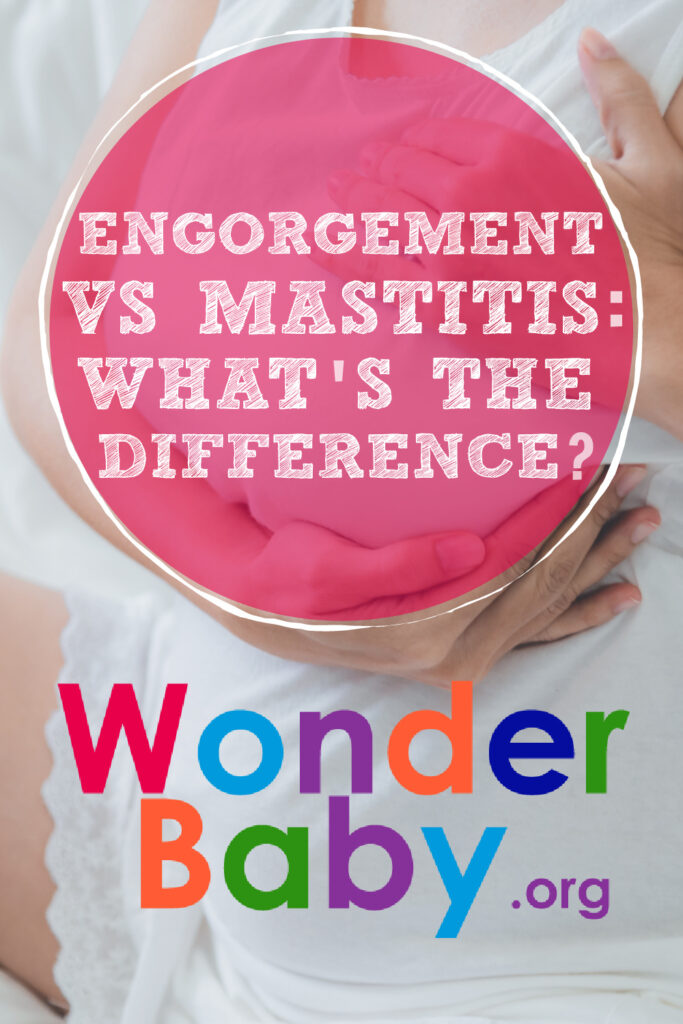Engorgement vs Mastitis: What’s the Difference?

- Breast engorgement is an overly full breast that can be uncomfortable.
- Mastitis is a breast infection that may occur from engorgement, a clogged milk duct, or cracked nipples.
- Breast engorgement can be remedied with specific home treatment and breastfeeding techniques.
- A physician must treat mastitis with antibiotics prescribed to cure the infection.
The terms mastitis and breast engorgement are often used interchangeably when describing a full and sore breast of a nursing mother. However, there are stark differences between the two conditions. It’s important to know if you are dealing with a simple case of breast engorgement vs mastitis, which is a serious medical issue.
Breastfeeding mothers have a lot on their plate between caring for themselves post-delivery and a new baby that needs much attention. It’s easy to be overwhelmed by the new responsibility of a newborn and breastfeeding, along with your other obligations.
Still, as a busy nursing mom, you cannot ignore important signs of a problem with your breasts. Familiarizing yourself with the symptoms of breast conditions such as engorgement and mastitis is essential for your breast health. Knowing how to keep your milk flowing by taking measures to prevent these issues will keep you and your baby happy in the long run.
What is Breast Engorgement?
Breast engorgement is an overly full breast that can cause pain. A swollen breast can happen when your milk comes in, at any time throughout the breastfeeding process or when you try to stop nursing.
Although engorged breasts are not a serious medical condition, they can interfere with breastfeeding due to mom dealing with tender breasts and baby having difficulty latching on to a bulging breast and extended nipple.
Breast engorgement is a common problem for nursing moms. So much so that a recent report in the Journal of Reproductive Medicine Gynaecology & Obstetrics, which studied 90 lactating mothers, concluded that a startling 65% to 75% of moms experience engorged breasts. The report further noted that ”breast engorgement is a major issue [for] lactating mothers” that can lead to “many problems like blocked milk ducts, feeding difficulties, a depressed milk ejection reflex, infection, inflammation of the breast and sore/cracked nipples.”

What Are the Causes of Engorgement?
We are all anxious about keeping our babies well-nourished and content at the breast. Thus, many mothers worry about their milk drying up while nursing their precious little ones.
On the other hand, too much milk can be a problem for breastfeeding mothers, although engorgement is normal as your milk supply begins to come in. Gagging, choking, and breast milk running out of your baby’s mouth while feeding are all indicators of breast milk oversupply that may lead to engorgement.
Certain circumstances can cause breast engorgement that nursing moms should be aware of, such as:
- Abruptly stopping breastfeeding or weaning too quickly
- Not completely emptying the breast at each nursing or pumping session
- Not alternating sides when feeding or pumping
- Skipping feedings (supplementing with formula)
- Difficulty with latch or sucking. Premature infants are particularly at risk for this issue.
- Baby has tongue tie
- Mother or child becomes ill
How Do I Know If My Breasts are Engorged?
A sore breast is the primary indicator of breast engorgement. Also, a forceful letdown when nursing is a warning that you may be heading towards a milk oversupply and swollen breasts. Breast milk squirting vigorously out of your nipple is a pretty good indication that your milk flow may be excessive and too much for your baby to handle, leaving your breasts overly full and tender.
Your breasts may feel hard, tight, heavy, and full when experiencing engorgement. Nursing mothers dealing with this issue are desperate to nurse or pump to relieve their fullness and discomfort. The blood vessels of the affected breast may also look distended and more noticeable.
This uncomfortable condition can affect one breast or both. Most importantly, it is vital at this point to know your next steps to alleviate engorgement before it develops into a more severe conditions like blocked ducts, sore nipples, or mastitis or affects your baby’s response to nursing.
How is Engorgement Treated?
Fortunately, engorged breasts are relatively simple to treat. It’s always wise to seek medical advice and your breastfeeding specialist when you have any nursing concerns. Engorged breasts are one issue that is important to discuss with your care team.
A phone call or visit may lead you to healthy breastfeeding before you feel worse or your swollen breasts cause a clogged milk duct.
Some specific measures to help relieve overly full breasts and reduce swelling can be:
- Warm compresses to the affected breast
- Fully emptying breasts when feeding or pumping
- Avoid tight and restrictive clothing on your torso, such as bras
- Continue breastfeeding even if you have swollen and tender breasts
- Take a warm shower and allow the water to flow gently over the affected breast
- Manually express a small amount of breast milk to alleviate some of the pressure before breastfeeding or between feeds
- Gently massage painful and hard breasts to increase milk flow
- Many mothers find relief with a cold compress applied to the affected breast
- Take pain medication according to your doctor’s instructions
Some lactating moms have found that applying cabbage leaves to the affected breast may also help to relieve pain and swelling.

What is Mastitis?
Mastitis is an engorged breast that has developed into an infection. The breast tissue becomes inflamed often due to a clogged milk duct from a build-up of milk, called milk stasis. Another cause is bacteria entering a crack or open area on the nipple. Cracked and dry nipples are a precursor to mastitis, as the tiny fissures can allow bacteria to enter the breast’s blood vessels.
What are the Symptoms of Mastitis?
Along with having tender and engorged breasts, mastitis may resemble the flu as the condition has now turned into a serious infection.
There are distinct red flags to be aware of that signal that mastitis has developed in a breast, such as:
- Red, hot breast
- Breast pain
- Fever
- Flu-like symptoms such as headache, fatigue, and body aches
- Lump in breast
Unlike engorgement, mastitis also most commonly only affects one breast.
How is Mastitis Treated?
Mastitis is treated by incorporating the measures listed above for breast engorgement. However, there is one vital addition to the mastitis treatment plan, and that is antibiotics. Since mastitis is an urgent medical condition and infection, you will need to seek medical advice as soon as you suspect that you may be dealing with mastitis.
Antibiotic therapy is the only way to treat a mastitis infection effectively. Comfort measures such as warm compresses with moist heat and pain medication will help alleviate the discomfort associated with mastitis.
Remember, if engorgement is left untreated, it can lead to mastitis, so initiating the comfort measures for engorgement can also be crucial preventive care.
Engorgement vs Mastitis: How to Tell the Difference
It can be reassuring to know when to call your doctor about serious breast issues.
The table below will help you identify the difference between engorgement and mastitis so you can confidently talk to your provider about any breast concerns.
| Engorgement | Mastitis |
| Breast full and hard | Breast full and hard |
| May or may not have a painful lump | Usually has a painful lump |
| Tender breast | Breast exquisitely tender |
| Breast is not red | Breast has an angry red hot area |
| No fever | Fever/chills |
| No severe fatigue | Severe fatigue |
| No body aches | Body aches |
| Relief when feeding or pumping | Feeding and pumping does not cure the problem |
As you can see, there are many similarities between engorgement and mastitis. The difference is that mastitis looks and feels more serious, along with the addition of flu-like symptoms such as fever.

Tips to Prevent Engorgement and Mastitis
It’s easier to prevent mastitis and engorgement than treat these issues. Knowing some simple measures to keep breast problems at bay will alleviate much pain and concern while nursing your little one.
Engorgement and mastitis prevention follow the same guidelines.
The following tips to prevent engorgement and mastitis should be initiated as soon as you start nursing.
- Alternate breasts for feeding
- Have baby fully and effectively drain breast when nursing
- Avoid tight clothing on upper torso such as restrictive bras
- Continue breastfeeding even if having issues with engorgement and mastitis
- Wean slowly
- When bottle feeding your baby, keep the same nursing schedule by fully emptying your breasts by pumping
- Keep nipples healthy and free from cracks by applying nipple creams and consulting with your provider if you notice cracked nipples.
- Inspect your breasts for hard lumps and redness
- Run warm water over breasts and gently massage to keep them soft
When to Call the Doctor
Seek medical advice from your doctor and lactation consultant when you first notice breast engorgement. They will reinforce measures to prevent mastitis and provide comfort and relief from swollen breasts.
If you notice that you have a red and hot breast that is painful to the touch, along with a fever or other symptoms similar to the flu, do not delay contacting your provider. Mastitis can turn serious quite quickly, causing you to be very ill.
Never feel ashamed to ask for help with breast or nursing concerns. Most lactating mothers seek the counsel of their providers and feeding consultants regularly. Your health is too important to risk not calling.

The information WonderBaby provides is not intended to be, and does not constitute, medical or other health advice or diagnosis and should not be used as such. Always consult with a qualified medical professional about your specific circumstances.
Related Posts

Breastfeeding, Sleep
Sleep and Breastfeeding: A Comprehensive Guide for Nursing Moms
Many people assume breastfeeding and sleep training don’t go together, but it is possible to help your baby sleep better while continuing your breastfeeding journey.

Breastfeeding
Comfort Nursing: Pros, Cons, and How to Stop
Find out what comfort nursing is, when should you worry about it, and how to stop or limit your baby's comfort nursing (especially at night!).

Breastfeeding, Product Reviews
5 Best Breastfeeding Chairs for Nursing Moms of 2023
Whether you want a gentle rock, a smooth glide, or a cozy cuddle to soothe your baby to sleep, you’ll have your pick of the best breastfeeding chairs on the...